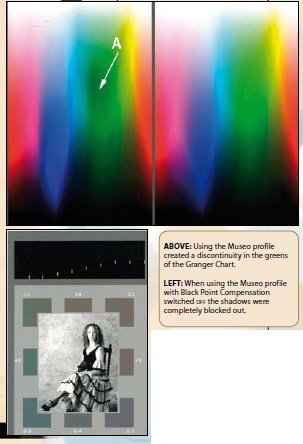articles/Paper/museofineartpaper-page2
Museo Fine Art Paper - Paper Chase - part 2 of 1 2 3 4 5 6
Published 01/10/2008

General Properties
The Museo products are all made with the purest form of cellulose, Cotton Rag, hence they are termed 100% Rag. To maintain the archival storage properties of the media they are also calcium carbonate buffered so that they remain acid free. Optical brightening agents are not used to improve the 'brightness' of the base paper or coating and so there is no opportunity for yellowing with age. This yellowing is the most serious criticism that the limited edition monochrome workers have of product such as Hahnemuhle Photo Rag.
In fact Hahnemuhle Photo Rag has a smattering of OBA in the base material because trimmings are fed back into the mash when making the base paper - very green-minded too! Other papers do undoubtedly yellow with age; we have plenty of examples lying around the office. It is particularly noticeable if a print has been left out partly exposed to the daylight and we have also noted paper reacting with the cheap paper we use for our general writing work when the two are left in contact. An inkjet surface seems a bit like a sponge for absorbing contamination from stuff it is in contact with, hence the care in packing the Museo product!
All Museo products have high natural brightness (as measured by the Lab luminance value) and they are all very similar slightly cream coloured, between two and three points up the Lab b scale. The spectral traces confirm a total absence of optical brighteners.
To save repeating ourselves under every sub-heading it is worth highlighting the general findings.
We did not find the profiles from the Museo website to be particularly to our liking although they returned quite good statistics. Generally the shadows were blocked up, in some instances so far that they were off our measuring scale which stops at 40 RGB points. All the surfaces showed some gloss differential and patchiness at the higher inking levels and a susceptibility to 'scuffing'. The image on the left is a glancing angle shot of a print on Museo Pan.
The disturbing gloss differential was also indicated in greyscale ramps as a tone discontinuity. Against this is the fact that these are truly archival materials, some of the best regarded in the field and you may have to apply a fixative coating such as Print Guard to finish the job. These are high-value media, intended for high-value work, and going the extra mile should be worth it or you might wish to look at alternatives! The number of samples available and time constraints forced us into using a 343-patch target to build our own profiles and we carried out none of the profile tuning that we would use for contract proofing set-up. Despite this, all our bespoke profile improved the statistics on colour audit.
All of the media except Archival Matt loaded successfully in the front, top tray (the sheet feed) of the test Epson 3800. The Archival Matt we had to load in the rear tray.
Museo Max
Please Note:
There is more than one page for this Article.
You are currently on page 2
- Museo Fine Art Paper - Paper Chase page 1
- Museo Fine Art Paper - Paper Chase page 2
- Museo Fine Art Paper - Paper Chase page 3
- Museo Fine Art Paper - Paper Chase page 4
- Museo Fine Art Paper - Paper Chase page 5
- Museo Fine Art Paper - Paper Chase page 6
1st Published 01/10/2008
last update 09/12/2022 14:56:53
More Paper Articles
There are 29 days to get ready for The Society of Photographers Convention and Trade Show at The Novotel London West, Hammersmith ...
which starts on Wednesday 14th January 2026





